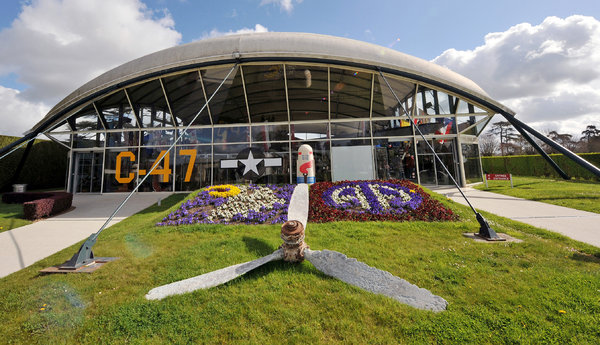Sainte-Mère-Église, a commune in the Manche department of Normandy, is a town bustling with the memory of its D-Day past. Themed hotels and eateries run down along the roads, and an approximately 70 or so museums join them. All having some sort of dedication to the many facets of the battle that took place within the township. There is no village elsewhere in Normandy where the reminder of the liberation that occurred in France, is kept thriving and more bubbling with life. The town, only houses around 1600 villagers, located all along the main roads in Cherbourg. Which is strategically 40 miles off to the north.
The village holds the area to the site of the ‘Musée Airborne’, which opened around the time of 1964 and dedicates itself to the memory of the troops who set foot in Normandy on the night of the 5-6th of June. This year the commemorative service has added a third building to its massive 107,000 square foot plot of land. Its two previous buildings are tactfully moulded to look like parachutes, which helps to tell the story of assaults that were initiated by airborne offensives on D-Day. The museum not only showcases its many large and small-scale sets of memorabilia, but chooses to also explain the many equipment used during the fighting, and the training that was underwent by the soldiers and pilots. As well as a quick analysis of the manufacturers of the planes and gliders in WWII. One of the most beautiful and intact pieces within Musée Airborne’s possession is a very rare C-47, this specific plane actually flew during the invasion. The aircraft, a massive transport carrier, is nearly to the size of 64-feet long, adorning a 95-foot wingspan.
Aside from the museum itself, the centre of the town in which it lays, was the setting of an intense firefight. Paratroopers were later to land in the village square. Humorously, one parachute of a soldier who went by the name of ‘John Steele’, a North-Carolina man. Became ensnared in the steeple of the town’s church. He remained hanging as the battle beneath him exploded and tumbled on, destruction dangling just underneath his feet as he swayed helplessly. His situation was actually shown in the film “The Longest Day’, which aired in 1962. If you are of course interested.
Nowadays a memorial piece of Steele dangles from the church exactly where he was caught up. A human flag of what is now luckily long past.
What’s very interesting to any tourist who visits the ‘attraction’ that is the very town, is the fact that nearly the entirety of the village stands to be its own living-museum. Everything remains a tribute to those who were liberated and to those who did the liberating.
One of the townspeople, Henri-Jean Renaud, who was there during the landings recalls the night when the American soldiers drifted down from the clouds. He was only ten years old to be exact, and he was the Mayor’s son. In 1944 on the 5th of June, Renaud now an 80-year-old man reminisces, how his Father had been called away because a house nearby off the town square had caught fire.
“Maybe a half-hour later, we hear a terrible noise,” said Mr. Renaud, whose family lived over the pharmacy his father also owned and operated. It was the sound of planes, hundreds of them, flying low overhead. “We hear shouting outside, guns. My brother and I tried to look out the window. My mother said, ‘No, no!’ pulled us back and we all knelt and prayed.”
Mr. Renaud manages to remember when his Father returned home to their family an hour or two later, fevered with excitement. He had heard of rumours in which entailed the prospect of the long-awaited invasion into Nazi-occupied France by the Allies. It seemed an immanency in the near future for them. However there was deep-rooted concerns that the Allied Powers might only begin small sized and limited reconnaissance, The New York Times reports.
Luckily for them however it was truly the liberation they had all been waiting for, because soon their town of Ste-Mère-Église rested as the beginning of the D-Day assault. The people of France dominated by German rule were exalting in the fact that help had finally come.
“If the Germans had succeeded, they would have destroyed the whole town and killed everybody,” Mr. Renaud says. “Thank God, these guys succeeded in stopping them. The feeling of the people here is so strong because of that.”
Ste-Mère-Église remains the perfect encapsulation of Normandy’s war riddled past, and holds within an array of wonderful historical artefacts. And, stories yet to be told.
